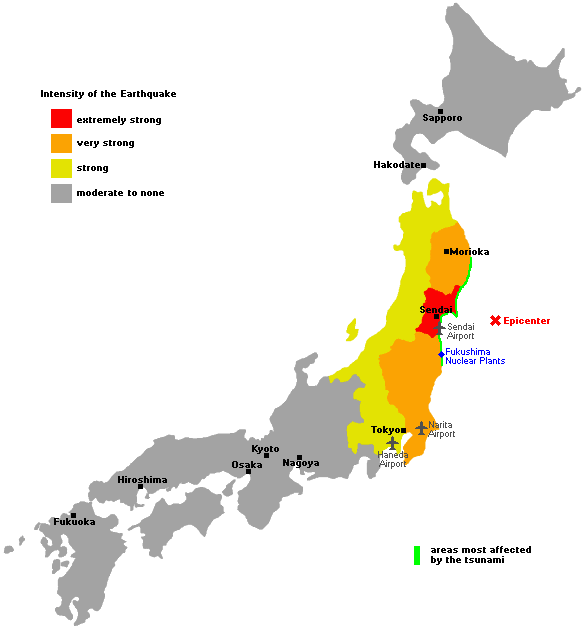Strong earthquakes hit the Tohoku Region in the afternoon of March 11, triggering several meter high tsunami waves that caused massive destruction and loss of human lives in areas along the Pacific coast of eastern Japan, especially in Miyagi, Iwate and Fukushima Prefectures.

The earthquake itself caused some major damage in areas close to the epicenter, as well as scattered fires and damage across the Tohoku and eastern Kanto area, although it did not cause widespread damage in any major city as seen in Kobe in 1995. The tsunami, however, caused extensive damage beyond imagination in coastal areas along the Pacific coast of northeastern Honshu.
Two nuclear reactors at the coast of Fukushima Prefecture also suffered damage from the earthquake and tsunami. Authorities have issued evacuation orders to people living within 20 kilometers of the first reactor and within 10 kilometers of the second reactor.
Effects on air traffic
All major airports re-opened within 24 hours of the earthquake. After massive flight cancellations yesterday, air traffic is normalizing today. Inquire with your airline on details about specific flights.
- Narita Airport (Tokyo): The airport re-opened yesterday, and is back to almost normal business today. JR and Keisei resumed train service between the airport and central Tokyo yesterday, while Skyliner and Narita Express trains resumed operation today. Some airport bus lines, however, remain out of service.
- Haneda Airport (Tokyo): The airport re-opened within hours of the earthquake, and operation is almost back to normal. Monorail and train access to the airport was resumed on the 12th.
- Sendai Airport, which was directly hit by the tsunami, can be expected to remain closed for some time to come. The two small airports of Hanamaki and Ibaraki also remain closed.
- All other airports, including Osaka's Kansai Airport, Nagoya's Central Japan Airport and Fukushima Airport, are open.
Some tourist sights in the Tokyo area remain closed for security checks. Tokyo Disney Resort announced that although there has been no major damage, its two theme parks will remain closed through March 20 for security checks and maintenance. Tokyo Tower will reopen on March 17.
Effect on trips to Japan
The effect on tourist activities is likely to be rather low except in the Tohoku Region where transportation will probably remain an issue for a few days to come.
No major tourist destination seemed to have suffered major damage with the possible exception of Matsushima which was hit by both the earthquake and tsunami, but details are not known to us at this time. Parts of central Hakodate, including the morning market area, were flooded with some damage caused. Central Sendai and Morioka did not suffer widespread major damage, but it will take time for the situation to normalize there.
Aftershocks can be expected to continue for several days in the Tohoku Region and surrounding areas with a steadily decreasing probability of another major tremor. Prospective travelers should also keep an eye on the evolving matter regarding the Fukushima nuclear plants, but avoid the sensationalist type of media as a source of information.
Considering the current overall situation, we believe that there is little reason to cancel travel plans for Japan unless you were scheduled to visit the coastal areas of the eastern Tohoku Region. Travel plan changes are likely necessary for those who intended to visit or pass through the Tohoku Region over the next few days due to transportation issues.


LET WE PRAY FOR
THE JAPAN VICTIMS!!
No comments:
Post a Comment